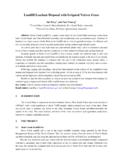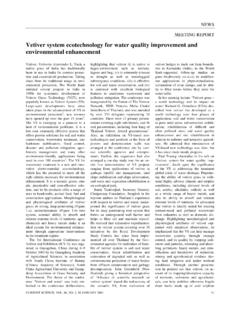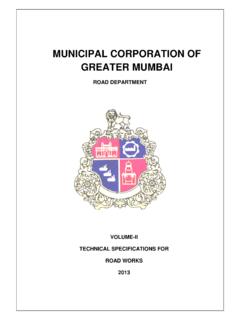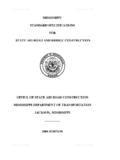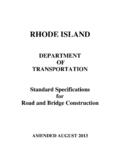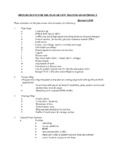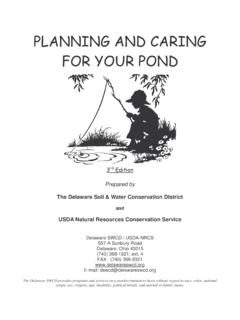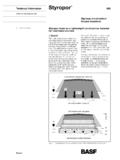Transcription of EMBANKMENT EROSION CONTROL: TOWARDS …
1 307 EMBANKMENT EROSION CONTROL: TOWARDS CHEAP AND simple practical solutions FOR BANGLADESHMd. Nazrul IslamCoastal EMBANKMENT Rehabilitation ProjectSouth Khulshi, Chittagong, BangladeshAbstractCostly rehabilitation to combat EROSION of earth embankments has been going on in bangladesh sincetime immemorial. Institutional steps started during the 1960s and nearly 13 000 km of embankmentshave been constructed to safeguard against inundation, intrusion of saline water and devastation. Asystem of routine maintenance could not be established, mainly due to institutional shortcomings andthe lack of an appropriate system of EROSION control . Maintenance has been restricted to major repairsonly when embankments were close to failure or had completely failed and caused serious losses. Soilthus eroded, including from other constructions, terraces and slopes and accumulated in water bodies(more than 2 700 million m3/year) disrupting the transportation system, affecting productivity anddeteriorating the environment.
2 To combat this disaster, EROSION control is necessary and must betechnically suitable, cost-effective, people-oriented, sustainable and environmentally Coastal EMBANKMENT Rehabilitation Project (CERP) has adopted the land-use approach forbiological means of protection against EROSION . To control runoff EROSION of embankments, modelshave been developed with vetiver and other associates combined with low-cost mechanical is one of the least developed and most densely populated countries of the world. The greatmajority of the people directly or indirectly depend on agriculture for earning a living. The annualgrowth rate of GDP is greatly dependent on agricultural produce. With the aim of increasingagricultural production, construction of earth embankments and dykes, their repairing and rebuildingfor irrigation, flood control and drainage have been the history of bangladesh since time zamindar (landlord) system came into existence long ago to organize agricultural steps for constructing embankments started with the creation of the East Pakistan Waterand Power Development Authority (EPWAPDA) in 1959.
3 After the independence of bangladesh ,EPWAPDA was split in 1972 into two organizations, namely the bangladesh Water DevelopmentBoard (BWDB) and the bangladesh Power Development Board (BPDB). EMBANKMENT , dykes andother allied structure fall under BWDB to save life and properties from natural disasters and toincrease agricultural production. Over the last few decades, nearly 13 000 km of embankments havebeen constructed1: Over 4 000 km of coastal embankments along the coastline surrounding the Bay of Bengal andoffshore islands2 Nearly 4 600 km of embankments along the bank of big rivers flowing across the country3 Nearly 4 500 km of low-lying embankments along the small rivers, haors and canals4To develop an effective system of irrigation, flood control and drainage, a few thousand alliedstructures also form the integral part of embankments. 1 488 regulators/sluices, 108 bridges and 923 1 The bangladesh Observer, , 20 August 19992 BWDB statistics of 30/6/19983 Ditto4 Adjusted from total length of 13 000 km308other structures have been constructed in 135 polders over 472 km of EMBANKMENT to protect ha of embankments protect lives and property from inundation during the monsoon.
4 Seaembankments of the offshore islands and coastal zones provide safeguard against the intrusion ofsaline water and devastation associated with repeated attacks of tidal surges and cyclonic minimize the impact of natural disasters as well as to achieve the aim of agricultural production,sustainable and cost-effective maintenance of those embankments and allied structures is a sine quanon for of EROSION and Their EffectsEarth embankments in bangladesh are beset with multi-facetted problems. The design andconstruction methods used to build the embankments, the nature and extent of erosive forces todestabilize them and above all the attitude of the local people for whom they are built altogetherdetermine the magnitude and degree of earthen embankments face light to moderate EROSION problems arising out of rainfall splash,animal actions and the nature of human uses.
5 Some of the critically positioned submerged types ofembankment in haor areas of the eastern part and river embankments of the main land are subjected toturbulent water currents and changes in river courses. The problem is acute in offshore islands andcoastal belts where the embankments are in addition exposed to EROSION by sea waves and tidalfluctuation of water estimate prepared by BWDB in 1984 shows that about 1 200 km of bank length of rivers weresubjected to EROSION , 565 km of which faced severe EROSION problems. The instability in river regimecoupled with huge discharge and sediment load cause EROSION , scouring and also deposition, and thus achain action proceeds. This is almost a recurring phenomenon. As per the latest information availablefrom BWDB, it is found that 441 projects/sub-projects are either fully or partially damaged due to thesevere floods of 1998. The total estimated cost of the rehabilitation works listed below is aboutUS$ million.
6 EMBANKMENT 2 987 km Irrigation/Drainage canal 373 km Water control structures 1 031 Protection works 187In the coastal belt and offshore islands also, severe bank EROSION problems occur frequently. Newaccretion and shifting of the bank line due to EROSION happen almost in the same way as those observedin the inland rivers. However, the nature and extent of erosive forces damaging the seashore andsuccessively the dykes differ in certain aspects from those of the inland process of EROSION gradually destroys the shore lands/riverbanks, foreshore areas/berms andsuccessively the earthen embankments engulfing the plain agricultural lands, habitats and manyimportant installations. In the affected reaches, the embankments built with adequate setback are foundto disappear within a year or two of the start of EROSION . Generally new embankments are constructedalong separate alignments (further back in the countryside), simultaneously adopting sufficientmeasures to check the bank EROSION .
7 Whenever the situation compels to protect the high-value assetsand important installations as the losses are really irreparable or would have a great impact on thenational economy, sophisticated structural means of proven engineering solutions involving huge costsare often adopted to combat the erosive constructions vulnerable to rain and flood damage include about 7 000 km of national highways,90 000 km of feeder roads and millions of homestead flat forms. In addition, agricultural and forestland on terraces and hill slopes are subjected to sheet and gully EROSION during the monsoon. Soil thuseroded each year becomes accumulated in rivers, reservoirs, harbors, estuaries and other water bodies, 5 Annex 1, Inception Report of 2nd CERP (September 1999), JPC309disrupting the water transportation system, shrinking fish habitat and affecting surface water storagecapacity and groundwater recharge.
8 All this affects the productivity of agriculture, fishery andlivestock. Frequent dredging or re-excavation of silted-up water bodies is costly. These consequentlydeteriorate the overall environment of the volume of silt deposited in bangladesh each year including the silt received from across theborder amounts to more than million m3. Dredging the volume of silt deposited each year bydeploying all the dredge power of bangladesh 24 hours a day and 365 days a year would require ahundred EROSION creates a double disaster EROSION of resources from where it is mostly wanted andsimultaneous accumulation where it is most common causes are natural forces and human ForcesThe natural forces cause EROSION of the embankments in the following way:Rainfall impact (from both the regular monsoon rains and torrential rains): Mean annual rainfallvaries from about 1500 mm in the northwest (Khulna district) to over 3750 mm in the south (Cox sBazar).
9 The heaviest rainfall occurs in July and ranges from 350 mm to over 875 mm slope EROSION caused by rain runoff is enormous and its speed/force grows exponentially towardsthe toe. Toe EROSION is the combined effect of runoff and wave action. The main features of rainfallimpact are: The EMBANKMENT crest is mainly affected with the formation of ghoghs and initiation of pipingaction leading to collapses in combination with either. Surface runoff caused by rainfall results in sheet EROSION and the formation of gullies and rillson poorly protected EMBANKMENT shoulders, slopes and toes. Flooding (monsoon/periodic floods and those created by storms/cyclones). The high head of water on the river side induces piping across the EMBANKMENT , which maylead to breaching and collapse of the polder system. Monsoon flooding often gives rise to serious EROSION of embankments by undermining due tocurrent, vortex and wave forces; the entire EMBANKMENT gets affected, beginning with thedamage of shoulders and crest due to undermining, and gradually the overtopping causes acomplete wash action (daily/periodic and created by constant wind) Tidal waves cause damage to the embankments located too near to the sea (the earthenembankments in the coastal zones should have adequate setback not allowing its exposure towave actions).
10 A severe hydraulic load is steadily exerted on the toes and slopes and causeserosion. Cyclonic storms in the coastal zone (occurring repeatedly) act upon the water surface, causingit to advance TOWARDS the shore with enormous hydraulic loads. The waves thus formedeventually hit the EMBANKMENT toe and slopes. The high hydraulic loads exerted on theembankment cause EROSION and if there is overtopping, the physical structure of theembankment is water currents (mainly in rivers and at coastlines) The high velocity flow of water associated with vortex motion in rivers and estuaries oftencauses EROSION of the banks by undermining, and the eventual collapse of the embankmentthreatens unless protective measures are taken. 6 Professor Ainon Nishat, BUET/Dr. M. M. Hassan, The bangladesh Observer, , Source: bangladesh Meteorological Department310 At the mouth of a branch river or canal, especially in the surroundings of sluice gates, theturbulent water current erodes the banks and subsequently the embankments.

